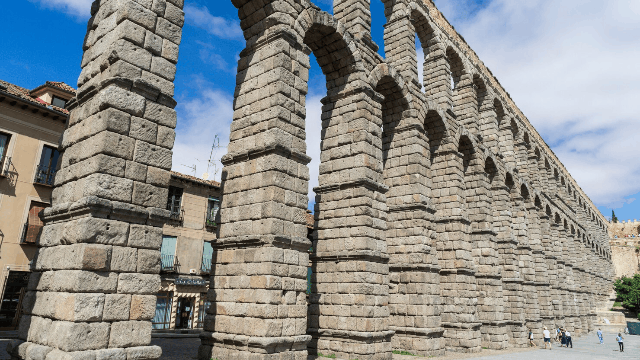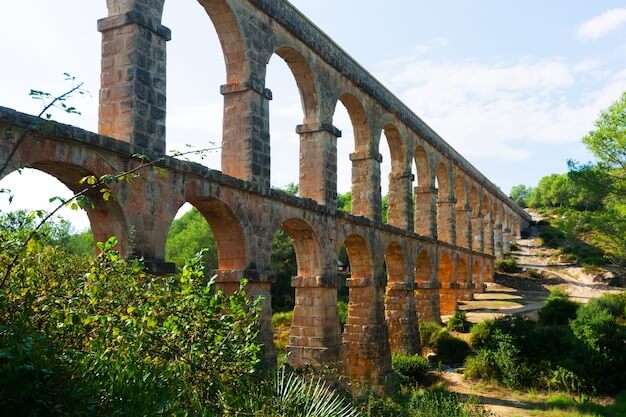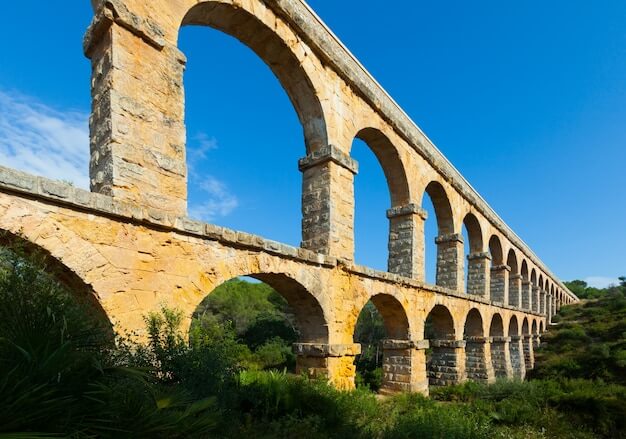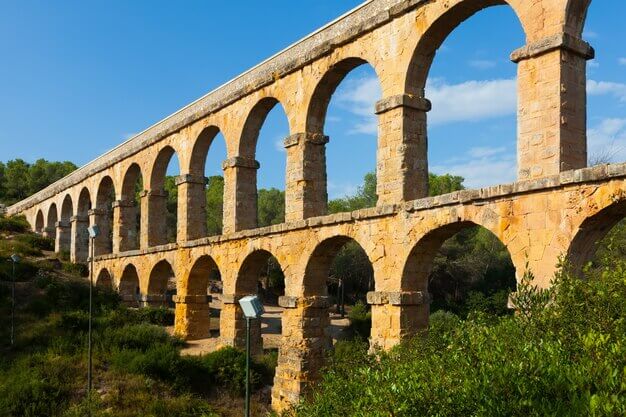Use the Millennium Canal~Segovia aqueduct

Segovia aqueduct, which has been used for thousands of years and is now in good condition and has an average slope of 1%, was once the framework of the Spanish city of Segovia. This amazing double-arch building is embedded in the magnificent ancient city of Segovia, and becomes a symbol of Segovia's pride.
Segovia aqueduct, also known as El Puente, is a water conveyance structure built during the reign of the Roman emperor Trajan (who reigned from 98 to 117 AD) and is still in use; It carries water from the Rio Frio River to the Spanish city of Segovia for 16 kilometers (10 miles). The aqueduct is one of the best-preserved Roman projects, and was designated as the Segovia World Heritage by UNESCO in 1985.
Segovia, a city in central Spain, is located in the Castilla and Leon Autonomous Region in central and western Spain. This important city has rich historical and cultural landscapes, and is located on an important trade route between Merida and Zaragoza. In ancient history, this was an important Celtic settlement, which was later controlled by the Romans. The city is located on a steep and isolated hill, built at the junction of two rivers, and on the main road between Caesar Augusta and Emerita, two important Roman settlements.

With the continuous expansion of the city, the population is gradually increasing, and there is a lack of fresh water near the city, which leads to the need for a water conveyance channel to supply water for the town.
The actual waterway system length of the Segovia aqueduct is close to 10.6 miles (17 kilometers). It is transported to the city from the Rio Frio River, which is 11 miles from the city of La Acebeda. This river is located on the mountains and belongs to the Guadalama Mountains.
The Romans liked spring water as a source of water. Compared with rivers, spring water has less pollution risk and more pure water quality. However, in Segovia, the Romans had to use the Rio Frio River as their water source. The Rio Frio River is located at 13509 feet (1255 meters) high. The water is first collected in a tank and then led to the second tower through a channel. There, water is diverted to the channel at the beginning of the aqueduct. The total length of the aqueduct is 14 kilometers, which is integrated with valleys, hills and cities, creating a magnificent and immortal feeling.
The channel will carry water through the rolling hills to Segovia and Archa Castle. The castle itself was built in the 12th century.
The exact construction time of this aqueduct has never been determined 100% accurately. Because it does not have any key inscriptions to help determine the age, this building has been a highly controversial topic among historians for a long time. Most experts and scholars agree on the general timetable for the first century AD. This set the construction period in the reign of Roman emperors Domitian, Turajin and Narva.
Segovia aqueduct is constructed of about 24000 dark granite blocks. Interestingly, they were originally constructed without any mortar. The aboveground part is 728 meters (2388 feet) long and consists of 165 arches with a height of 9 meters (30 feet). In the center, the slope of the terrain requires two arches; There, the building is 28.5 meters (93.5 feet) above the ground. The Romans closed the gap by building a two-story stone arch, which supported part of the wall and water channel above.
The granite used to build the aqueduct is mined locally, about 3.1 miles (5 kilometers) from Segovia, which is a great feat. Many granite blocks weigh one ton, and the largest block weighs two tons. The whole aqueduct bridge weighs nearly 20000 tons.
This aqueduct bridge is only a small part of the whole water supply channel, accounting for about 5% of the total length.

Aerial view of Segovia aqueduct
The first major threat to the aqueduct was during the reign of Alfonso VI. In 1072, Yehya Ibn Ismail Mamon, the king of Toledo, a Berber Muslim, tried to conquer Segovia. During this process, part of the aqueduct was damaged, with about 36 arches. Later, some dislocated granite blocks were used by Alfonso VI to reinforce his castle.
Around 1483, during the reign of Isabella I of Castile y ó n, the damaged arch was rebuilt as accurately as possible.
In the 19th and 20th centuries, the modernization of Segovia's city and the emergence of motor vehicles threatened the survival of the aqueduct, although it was included in the UNESCO World Heritage List together with the entire old city of Segovia in 1985.
The segovia aqueduct is at a busy traffic intersection, and vehicles pass back and forth in several lanes between the ancient Roman arches. Local officials even proposed to remove one of the central arches to ease traffic flow.

Traffic is a major threat to the aqueduct, because the vibration of many passing vehicles causes cracks and makes the structure unstable. In the late 1980s, engineers pleaded with the public, claiming that traffic congestion and continued neglect of the monument's safety would lead to the imminent collapse of the monument.
After this disturbing warning, the European Commission sent a delegation composed of several chief engineers to determine the actual state of the aqueduct. It is proved that several key aspects leading to the deterioration of the aqueduct are mainly stone weathering, vehicle pollution and continuous vibration.
In 1992, all traffic vehicles under and around the aqueduct bridge were banned. After this achievement, the local administrative committee started a special protection campaign and made many key efforts to extend the life of Spain's national treasure.
Segovia aqueduct is a huge and incredible building. It ruled Segovia and is an unshakable witness of the far-reaching Roman Empire and its brilliant achievements. It is also one of the best preserved ancient Roman works in the Iberian Peninsula.
This immortal building still stands almost 2000 years after its completion, which is as amazing as the first day. Its water conveyance function is still in use today. Although it has been repaired for hundreds of years, it has not changed any original structure.
In November 2009, Spain, in cooperation with the UNESCO World Heritage Center, held a technical seminar in Segovia. The seminar confirmed the urgent need to implement a management plan to protect and maintain the monument. At the end of winter 2010, the aqueduct was highly valued in the exhibition "Castile Le ó n Treasures along Santiago de Compostela" held by the Spanish Institute of Queen Sofia in New York City

